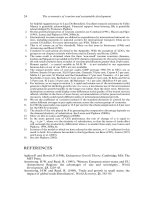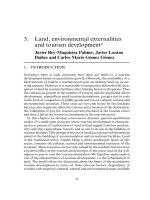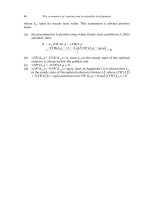THE ECONOMICS OF MONEY,BANKING, AND FINANCIAL MARKETS 496
Bạn đang xem bản rút gọn của tài liệu. Xem và tải ngay bản đầy đủ của tài liệu tại đây (41.21 KB, 1 trang )
464
PA R T V
Central Banking and the Conduct of Monetary Policy
reliable guide to monetary policy and, like the Federal Reserve, abandoned monetary targeting. Gerald Bouey, the governor of the Bank of Canada, described the
Bank of Canada s experience colourfully by saying, We didn t abandon monetary
aggregates; they abandoned us. A more detailed description of monetary targeting in Canada is provided later in this chapter.
The increase in oil prices in late 1973 was a major shock for Japan, which
experienced a huge jump in the inflation rate, to greater than 20% in 1974 a surge
facilitated by money growth in 1973 in excess of 20%. The Bank of Japan, like the
other central banks discussed here, began to pay more attention to money supply
growth rates. In 1978, the Bank of Japan began to announce forecasts at the beginning of each quarter for M2 * CDs. Although the Bank of Japan was not officially
committed to monetary targeting, monetary policy appeared to be more moneyfocused after 1978. For example, after the second oil price shock in 1979, the Bank
of Japan quickly reduced M2 * CDs growth, rather than allowing it to shoot up as
occurred after the first oil shock. The Bank of Japan now conducts monetary policy
with operating procedures that are similar in many ways to those of the Federal
Reserve. It uses the interest rate in the Japanese inter-bank market (similar to the federal funds market) as its daily operating target, just as the Fed does.
The Bank of Japan s monetary policy performance during the 1978 1987
period was much better than the Fed s. Money growth in Japan slowed gradually,
beginning in the mid-1970s, and was much less variable than in the United States.
The outcome was a more rapid braking of inflation and a lower average inflation
rate. In addition, these excellent results on inflation were achieved with lower variability in real output than in the United States.
In parallel with the United States and Canada, financial innovation and deregulation in Japan began to reduce the usefulness of the M2 * CDs monetary aggregate as an indicator of monetary policy. Because of concerns about the appreciation
of the yen, the Bank of Japan significantly increased the rate of money growth from
1987 to 1989. Many observers blame speculation in Japanese land and stock prices
(the bubble economy) on the increase in money growth. To reduce this speculation,
in 1989 the Bank of Japan switched to a tighter monetary policy aimed at slower
money growth. The aftermath was a substantial decline in land and stock prices
and the collapse of the bubble economy.
As a result, the Japanese economy was in a slump for ten years, often referred
to as the lost decade. The collapse of land and stock prices helped provoke a
severe banking crisis, discussed in Chapter 11, that was a severe drag on the economy. The resulting weakness of the economy even led to deflation, promoting further financial instability. The outcome was an economy that stagnated for over a
decade. Many critics believe that the Bank of Japan has pursued overly tight monetary policy and needs to substantially increase money growth in order to lift the
economy out of its stagnation.
JAPAN
Starting in the mid-1970s and continuing through the next two decades,
both Germany and Switzerland engaged in monetary targeting. The success of monetary targeting in controlling inflation in these two countries explains why monetary
targeting still has strong advocates and is an element of the official policy regime for
the European Central Bank (see the Global box, The European Central Bank s
Monetary Policy Strategy). Because the success of the German monetary targeting
regime in producing low inflation has received the most attention, we ll concentrate
on Germany s experience.
GERMANY









